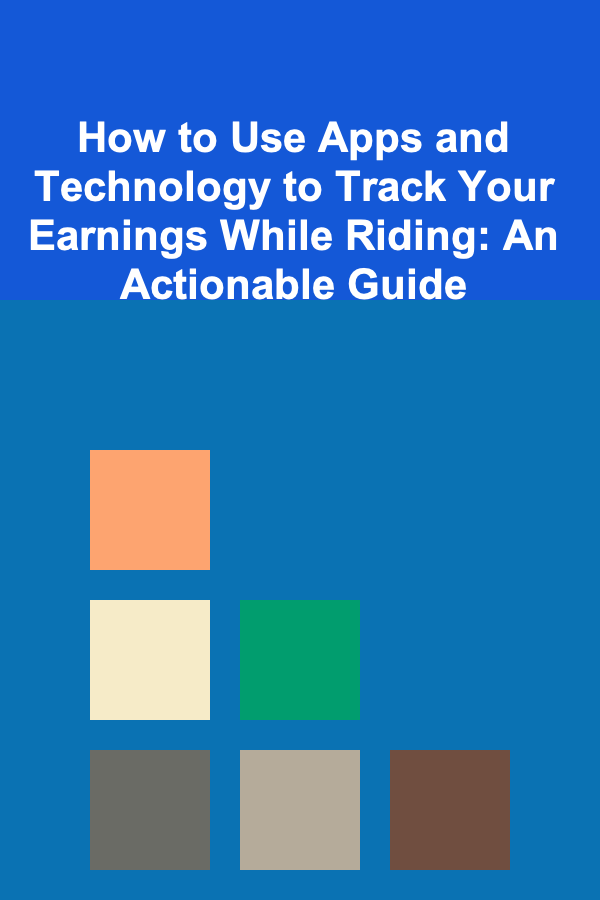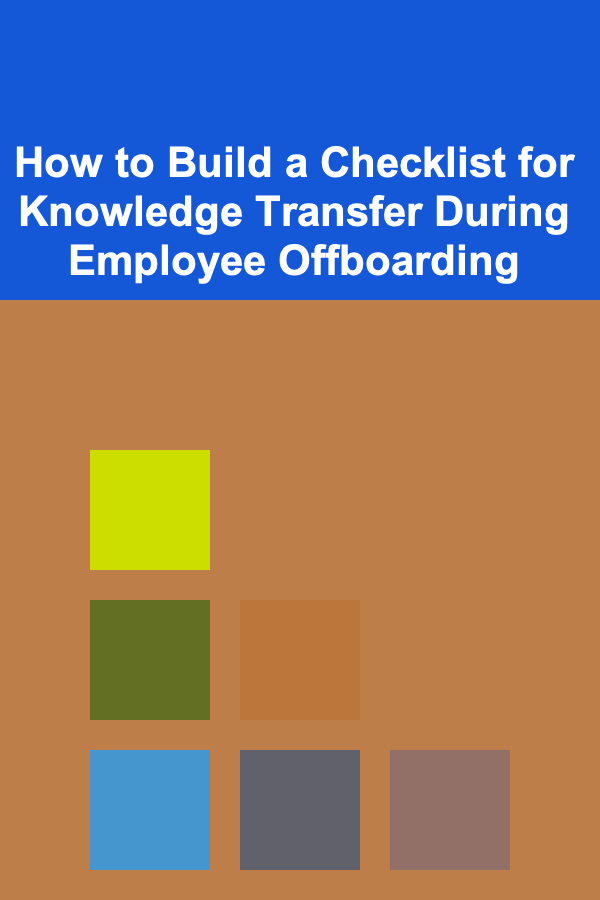
How to Use Apps and Technology to Track Your Earnings While Riding: An Actionable Guide
ebook include PDF & Audio bundle (Micro Guide)
$12.99$6.99
Limited Time Offer! Order within the next:

In today's fast-paced world, the gig economy has become a significant part of many people's careers, with riders and drivers using apps to earn money. Whether you're an Uber, Lyft, DoorDash, or any other type of delivery or rideshare driver, tracking your earnings efficiently is crucial to understanding your income and maximizing your profits. With the right tools, you can keep track of how much you're earning, when you're earning, and what factors influence your income.
This actionable guide explores how to leverage technology and apps to track your earnings while riding. We'll explore essential apps, tips for making the most of your technology, and how to use the data to optimize your income.
Leverage Your Rideshare and Delivery App's Built-In Features
Most rideshare and delivery platforms come with built-in tracking features to help you keep an eye on your earnings in real-time. These apps often give you a breakdown of your income, tips, and bonuses, so you don't have to manually calculate your profits.
Key Actions:
- Track Earnings in Real-Time: Platforms like Uber, Lyft, and DoorDash allow you to see your earnings as you complete rides or deliveries. You can check your daily earnings and weekly summaries. This data includes your base fare, tips, surge pricing, and any bonuses or incentives.
- Review Weekly Payouts: These platforms provide detailed weekly earnings statements, which include a breakdown of how much you made, how much was deducted for fees, and when you'll receive your payment. Reviewing these summaries can help you understand which days and times are the most profitable.
- Use Promotions and Bonuses: Many apps offer additional earnings opportunities through promotions, like surge pricing or quest bonuses. Pay close attention to these promotions and plan your schedule around them to increase your earnings.
Tips:
- Check your earnings frequently within the app to spot any discrepancies or missed bonuses.
- Set notifications for when promotions or surge pricing are active so you can take advantage of them.
Use Third-Party Earnings Tracker Apps
While rideshare platforms provide in-app tracking, third-party apps are designed to give you a more detailed and comprehensive view of your earnings, expenses, and performance. These apps allow you to track your rides, calculate your mileage, and manage your tax deductions.
Recommended Apps:
- Gridwise: Gridwise is an excellent app for tracking your earnings across multiple platforms. It integrates with services like Uber, Lyft, DoorDash, and more. It helps you track rides, deliveries, mileage, and even provides insights on which locations and times are most profitable. Gridwise also offers reports that can help you plan and optimize your earnings.
- Stride: Stride is focused on self-employed individuals and helps track your earnings, mileage, and deductions. This app automatically tracks your driving and categorizes your expenses, including gas and car maintenance, so you can save money come tax season.
- SherpaShare: SherpaShare offers automatic mileage tracking and can track your earnings across different gig economy platforms. It also allows you to analyze your data and improve your earnings strategy by showing which routes and times give you the most profit.
Key Features to Look For:
- Real-time Earnings Tracking: Choose an app that integrates with your rideshare or delivery service to give you live tracking of your earnings.
- Mileage Tracking: Since many gig workers can deduct mileage on their taxes, an app that tracks your mileage automatically is a huge time-saver.
- Expense Tracking: Look for apps that track expenses like gas, tolls, and maintenance. This information is vital when filing taxes.
Tips:
- Sync your third-party app with your rideshare apps to streamline your tracking process.
- Review weekly or monthly reports to spot trends and identify profitable periods or areas.
Optimize Earnings with Scheduling and Time Tracking Tools
Timing is everything when it comes to maximizing your earnings in the gig economy. Using scheduling and time-tracking apps will help you work during peak hours, reducing idle time and improving your overall income.
Recommended Tools:
- Rideshare Scheduler: This app helps you schedule your rides to work during peak times. It tracks when the most profitable periods (such as rush hours, weekends, and holidays) occur in your city, helping you optimize your work schedule.
- HoursTracker: If you want to track the time you spend working as well as your earnings, HoursTracker is a helpful tool. This app lets you log your start and end times and track the hours you've worked, which is particularly useful if you work multiple shifts across different platforms.
- Google Calendar: Although not specifically for gig workers, Google Calendar can help you schedule your work hours more effectively. Use it to block off your available times based on when you're most likely to earn more (such as evenings or weekends).
Tips:
- Analyze your past earnings to identify patterns in peak hours. Use this data to plan your shifts accordingly.
- Set reminders or alerts for when you want to start your ride or delivery shift, making sure you don't miss out on profitable hours.
Utilize Fuel and Expense Management Apps
Managing expenses is key to understanding how much profit you're actually making. Fuel, maintenance, and other vehicle-related costs can significantly eat into your earnings. Fortunately, there are apps designed to help you track these costs and calculate your net income.
Recommended Apps:
- Fuelly: Fuelly allows you to track your fuel usage and expenses. By logging each fill-up, you can see how much you're spending on gas and calculate your fuel efficiency. This app is especially useful if you're putting a lot of miles on your vehicle.
- Everlance: Everlance tracks both your mileage and expenses, including gas, car maintenance, and tolls. It also automatically categorizes expenses, helping you track your deductions for tax purposes.
- MileIQ: MileIQ is another app that tracks your mileage, but it also categorizes your trips, helping you separate personal and business use. You can then use this data for tax deductions, saving you money at the end of the year.
Key Features to Look For:
- Automatic Mileage Tracking: Choose apps that automatically log your miles, so you don't have to manually input data each time you drive.
- Expense Categorization: Apps that categorize expenses for you can help you keep track of both fixed and variable costs.
Tips:
- Keep track of your maintenance and fuel expenses throughout the year to accurately estimate your profits.
- Use the expense-tracking features to make sure you're deducting all eligible expenses during tax season.
Take Advantage of Analytics and Reports to Improve Your Strategy
To make data-driven decisions, it's important to dive deeper into your earnings analytics. Many apps and platforms provide detailed reports and analytics to help you assess your performance over time and adjust your strategy accordingly.
Key Actions:
- Look for Trends: Regularly review your earnings reports to identify trends. Which times, days, and locations are the most profitable? Use this information to fine-tune your schedule and improve your income.
- Assess Your Performance: Use analytics to track your efficiency, like how long you spend driving and how much you're earning per hour. If you're spending too much time driving between trips, consider adjusting your route or location.
- Set Goals and Track Progress: Setting realistic earning goals and tracking your progress can help keep you motivated and improve your work habits. Many apps, such as Gridwise and SherpaShare, let you set targets for daily, weekly, or monthly earnings and give you visual progress reports.
Tips:
- Use the data you gather to adjust your strategy. If you find that certain times or areas are particularly profitable, schedule more shifts during those windows.
- Set realistic income goals and track your progress to stay motivated and focused.
Conclusion
Technology is a powerful ally for anyone working in the gig economy, especially when it comes to rideshare or delivery services. By leveraging the built-in tools in your rideshare app, using third-party tracking apps, managing your schedule, and carefully tracking your expenses, you can optimize your earnings and run a more efficient and profitable business. With the right apps and a data-driven approach, you'll not only track your earnings but also make informed decisions that lead to higher profits and better financial management.

How to Build a Checklist for Knowledge Transfer During Employee Offboarding
Read More
How to Evaluate Home Security Services and Contracts
Read More
How to Offer Data Entry Services as a Part-Time Typist
Read More
How to Optimize Your Financial Plan for Tax Efficiency
Read More
How to Prevent Noise From Neighbors in Shared Walls
Read More
How to Use Your Professional Skills to Become a Part-Time Consultant
Read MoreOther Products

How to Build a Checklist for Knowledge Transfer During Employee Offboarding
Read More
How to Evaluate Home Security Services and Contracts
Read More
How to Offer Data Entry Services as a Part-Time Typist
Read More
How to Optimize Your Financial Plan for Tax Efficiency
Read More
How to Prevent Noise From Neighbors in Shared Walls
Read More